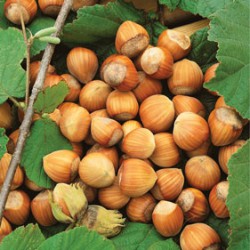
Thanks to John Harrison of Allotment & Gardens.
How to Grow Hazelnuts – A Guide to Growing Hazelnuts

Hazelnuts are easy to grow. They are often used as hedging and grown for their wood, as well as their delicious nuts. They are naturally vigorous, large multi-stemmed bushes, often coppiced for their wood.
Bees love the hazelnut’s catkins and flowers which appear in late winter/early spring. In autumn the leaves produce a beautiful show of colour making them an ideal decorative plant in the garden.
Growing Hazelnuts
- Pot grown plants can be put into the ground at any time of year, but it is best to plant during the dormant period in winter as long as the soil is not frozen or water-logged; bare rooted trees should be planted late autumn–early spring.
- Hazels can be planted in any moist but free draining soil, in a bright, sunny situation.
- Commonly brought as bare-rooted saplings, although pot grown plants are also available.
- Dig a hole large enough to comfortably accommodate the depth and size of the roots and water in well after planting.
- Remove any vegetation around the base of the sapling and mulch well, to help keep in the moisture and discourage weeds, etc, growing and competing with the young tree.
- Don’t let your hazelnut dry out during the first year – after that they are low maintenance.
Harvesting Hazelnuts
- Harvest late September–October.
- The nuts grow as clusters called burrs, and begin to form as the leaves grow. They are ready to harvest in the autumn once the leaves and burrs starting turning brown.
- Most of the burrs will fall to the ground naturally, but a few may need encouragement.
- Remove the nuts from their protective cases and place in a single layer in a warm, airy position to dry for a couple of days, before roasting.
Pests and Problems with Hazelnuts
- Protect the young trees from deer and rabbits, which will strip the bark from the trees.
- Squirrels will take the ripening and ripe nuts.
Varieties of Hazelnut
- You will find many varieties of hazelnut available, both traditional and modern. The purple filbert has attractive purple leaves, gorgeous colour in autumn and the RHS Award of Garden Merit.
- Not all hazelnuts are self-fertile. Wild hazelnuts growing nearby will serve as pollinators (they are wind pollinated) or buy at least two varieties for a reliable crop.
Eating
- Hazelnuts are delicious eaten raw or dry roasted, when they can then be stored in airtight containers or frozen.
- Place them on a baking tray, in a single layer, and oven roast at about 180º for around 20–30 minutes: check the nuts regularly, moving them around to ensure even roasting. They’re ready once the papery skins easily comes away from the nut.
